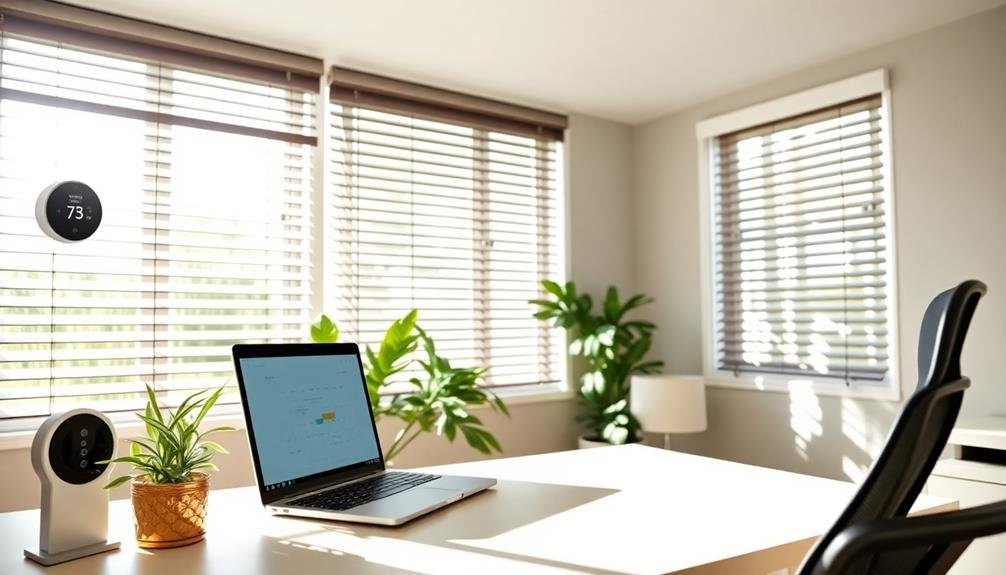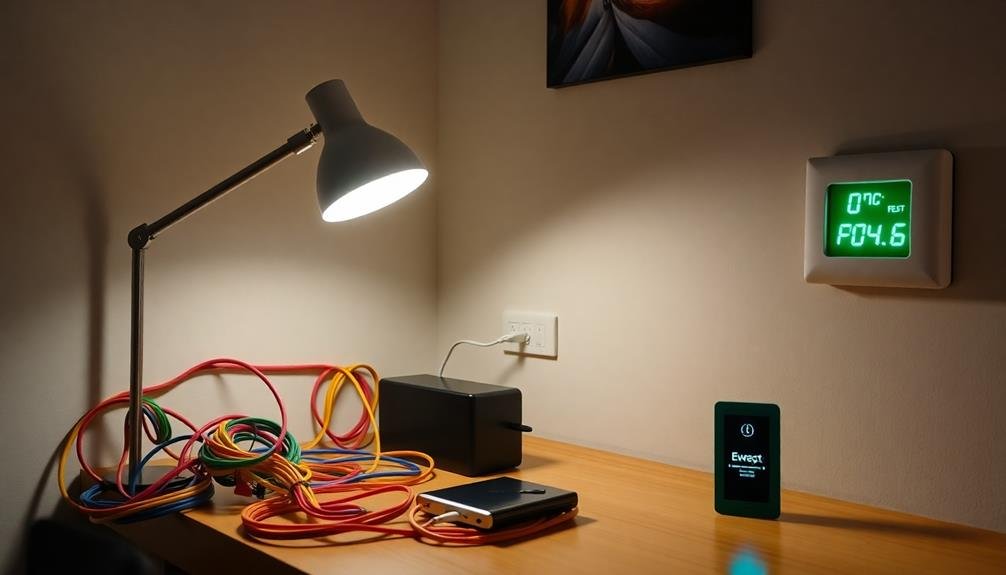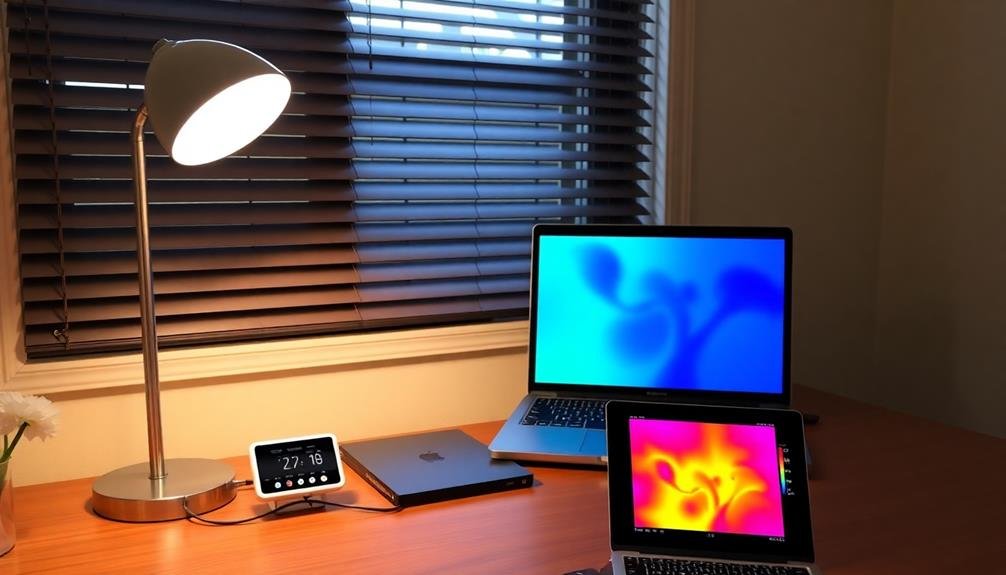You've likely noticed your energy bills climbing as temperatures soar, and traditional cooling methods just aren't cutting it anymore. Window heat extractors have evolved remarkably in 2025, offering innovative solutions that go beyond basic ventilation. From smart temperature controls to multi-directional airflow, these devices can transform your stuffy space into a comfortable haven. Let's explore the top performers that'll help you beat the heat without breaking the bank.
Comfort Zone Twin Window Fan with Reversible Airflow Control (CZ319WT)
The Comfort Zone Twin Window Fan (CZ319WT) stands out as an ideal choice for homeowners seeking versatile temperature control without breaking the bank. You'll appreciate its dual 9-inch fans that deliver airflow at 9.84 ft/sec, with two speed settings to match your comfort needs.
The fan's reversible airflow control lets you switch between intake and exhaust modes, while its accordion expanders fit windows from 22-1/4 to 33 inches. When you're not mounting it in a window, use its sturdy feet for tabletop placement. The removable bug screen makes cleaning a breeze, and the fabric cover protects against debris when stored.
Best For: Homeowners and apartment dwellers looking for an affordable, versatile cooling solution that can both bring in fresh air and exhaust stale air through windows ranging from 22-1/4 to 33 inches wide.
Pros:
- Versatile dual-fan design with reversible airflow control for both intake and exhaust functions
- Easy installation with expandable accordion panels and option for tabletop use
- Includes practical features like removable bug screen and protective fabric cover
Cons:
- Limited airflow capacity at 9.84 ft/sec compared to higher-powered alternatives
- Some users report noticeable buzzing noise when operating at high speed
- Durability concerns with accordion expanders and bug screen over extended use
Genesis Twin Fan High Velocity Window Fan with Reversible Airflow
Apartment dwellers and homeowners seeking powerful dual-motor ventilation will find the Genesis Twin Fan ideal for their cooling needs. With its dual 9-inch copper motors and Max Cool thermostat technology, you'll maintain precise temperature control between 60-80 degrees.
You can easily mount this 24x12x4-inch unit in most windows, thanks to its expandable side panels that stretch an additional 6.5 inches on each side. Three speed settings let you adjust airflow, while the reversible function switches between exhaust and intake. While it's effective at cooling rooms and clearing smoke, be aware that some users find the LED lights too bright and the noise levels higher than expected.
Best For: Apartment dwellers and homeowners looking for a powerful window-mounted cooling solution with precise temperature control and versatile airflow options.
Pros:
- Dual 9-inch fans with copper motors provide strong airflow and effective room cooling
- Versatile functionality with reversible airflow for both intake and exhaust operations
- Adjustable side panels expand up to 6.5 inches on each side for custom window fitting
Cons:
- Noise levels may be higher than expected, especially on lower settings
- Bright LED indicator lights can be disruptive during nighttime use
- Some users report reliability issues and malfunctions after short periods of use
Vornado TRANSOM Window Fan with Remote Control
Seeking a balance between power and quiet operation? The Vornado TRANSOM delivers with its whisper-quiet 45dB performance and robust airflow. You'll appreciate the versatile 4-speed settings and one-touch electronic reversal that lets you switch between intake and exhaust modes effortlessly.
At just 25 watts, this energy-efficient window fan fits openings from 26" to 40" wide. You'll love the convenience of the remote control and auto temperature feature that maintains your desired comfort level. While the foam blocks might need adjusting for a perfect fit, the 5-year warranty provides peace of mind for this sleek, ice-white cooling solution.
Best For: Homeowners and apartment dwellers seeking an energy-efficient, quiet window fan with smart features for customizable cooling and ventilation in medium to large rooms.
Pros:
- Extremely quiet operation at 45dB makes it ideal for bedrooms and quiet spaces
- Versatile functionality with 4 speeds, remote control, and automatic temperature control
- Energy efficient at only 25 watts while providing powerful airflow
Cons:
- Foam block system may not provide perfect seal in all window types
- Temperature sensor placement can lead to inaccurate readings
- Limited to single-hung and double-hung windows with specific size requirements
Bionaire Thin Window Fan with Manual Controls(BWF0502M-WM)
Cooling-conscious homeowners will appreciate the Bionaire Thin Window Fan's versatile performance and smart features. You'll get three speeds and reversible airflow that can draw in fresh air or expel heat. The programmable thermostat automatically maintains your desired temperature, while the remote control lets you adjust settings from anywhere in the room.
This fan fits windows 24 to 36 inches wide and effectively drops room temperature by several degrees within an hour. While the temperature gauge isn't perfect, you'll love how quietly it operates, creating gentle white noise that's perfect for sleeping. Installation is a breeze thanks to its lightweight design and accordion panels.
Best For: Apartment dwellers and homeowners seeking an efficient, programmable window fan with versatile cooling options and remote operation convenience.
Pros:
- Versatile 3-speed operation with reversible airflow for optimal temperature control
- Programmable thermostat with remote control for convenient operation
- Easy installation with expandable accordion panels fitting windows 24-36 inches wide
Cons:
- Temperature gauge readings may not accurately reflect room temperature
- Limited to horizontal installation in larger windows
- Produces some white noise, which may not suit light sleepers
Midea 5,000 BTU EasyCool Window Air Conditioner
Light sleepers and small-space dwellers will appreciate the Midea 5,000 BTU EasyCool Window Air Conditioner's whisper-quiet operation and compact design. It efficiently cools rooms up to 150 square feet with seven temperature settings and two cooling speeds.
You'll find installation straightforward with included mounting accessories – just grab a screwdriver and follow the manual. The unit's 11.0 CEER rating helps reduce energy costs, while its copper core and R410A refrigerant guarantee reliable cooling. For best results, clean the air filter regularly and maintain the outside condenser every two months. A one-year warranty covers parts and labor, with online registration for quick support.
Best For: Budget-conscious apartment dwellers and homeowners seeking an efficient, easy-to-install window AC unit for small rooms like bedrooms or home offices up to 150 square feet.
Pros:
- Energy efficient with 11.0 CEER rating and low power consumption
- Simple installation process with included mounting accessories
- Multiple comfort settings with 7 temperature options and 2-way air direction
Cons:
- Limited cooling capacity (only suitable for rooms up to 150 sq. ft.)
- No defrost cycle for operation below 41°F
- Mixed user feedback regarding noise levels despite quiet operation claims
BLACK+DECKER 9 Dual Window Fan with 2 Speed Settings
The BLACK+DECKER 9 Dual Window Fan helps homeowners tackle hot spots with its versatile dual-airflow design. At just 4.5 pounds, this lightweight unit fits most windows using its expandable accordion panels that stretch from 22.5 to 33 inches.
You'll appreciate the straightforward two-speed settings and the ability to switch between intake and exhaust modes, though you'll need to flip the fan manually. The rust-resistant construction guarantees durability, while the removable legs offer flexible installation options. Whether you're cooling your bedroom, kitchen, or living room, this fan's effective air circulation makes it a practical choice for whole-house cooling, especially when you install multiple units.
Best For: Budget-conscious homeowners seeking an efficient window fan solution for medium-sized rooms who don't mind basic features and manual operation.
Pros:
- Versatile installation with expandable panels and removable legs to fit various window sizes
- Lightweight and durable rust-resistant construction
- Effective dual-fan design with both intake and exhaust capabilities
Cons:
- Limited to only two speed settings
- Manual direction reversal required (no automatic switching)
- Basic mechanical controls may feel dated compared to modern electronic interfaces
Vornado PORTAL Window Fan with 3 Speeds and Reversible Exhaust
Power-seeking homeowners will appreciate the Vornado PORTAL Window Fan's robust airflow capabilities and versatile functionality. You'll get three speed settings and a reversible exhaust mode that lets you either draw in fresh air or expel stale air with ease.
The fan fits windows 24" to 38" wide, requiring at least 8" height clearance. While it operates quietly on lower settings, you might notice increased noise at higher speeds. You'll need to install it horizontally and may need to remove your window screen for proper fit. Despite some durability concerns, many users consider it the market's top window fan for its exceptional performance.
Best For: Homeowners seeking a powerful, adjustable window fan for efficient air circulation in medium to large rooms with standard double-hung or single-hung windows.
Pros:
- Strong airflow with three adjustable speeds and reversible functionality for both intake and exhaust
- Fits a wide range of window sizes (24" to 38") with straightforward horizontal installation
- Quiet operation at lower speeds while still maintaining effective air circulation
Cons:
- Can be notably noisy at higher speed settings
- May require window screen removal and extension cord for proper installation
- Some users report durability issues and increased noise over time
Factors to Consider When Choosing Window Heat Extractors for Summer Cooling
When choosing a window heat extractor for summer cooling, you'll need to match the unit's dimensions to your window opening and evaluate essential features like variable speed settings and reversible airflow. You should assess the fan's cooling power in relation to your room size, while considering the noise output that you're willing to tolerate in your living space. The unit's ease of installation and whether you'll want to move it between rooms can help determine if a lightweight, portable model better suits your needs.
Window Size and Fit
Proper sizing stands as the most critical factor when choosing a window heat extractor for your home. You'll need to carefully measure both the width and height of your window opening before making a purchase, as most models are designed to fit specific dimensions.
Most window heat extractors accommodate widths between 22 and 40 inches, with a minimum height requirement of 8 inches. If you're unsure about the exact fit, look for models with accordion-style expanders that offer more flexibility in sizing. Don't forget to verify your window type – whether it's single-hung, double-hung, or sliding – as this will affect installation and performance. For ideal results, consider fans designed for horizontal placement, and always check the product's minimum and maximum fitting specifications before making your final decision.
Airflow Control Options
Since effective summer cooling depends heavily on air circulation control, selecting a window heat extractor with versatile airflow options should be a top priority. You'll want to look for models that offer reversible airflow functionality, letting you switch between drawing in cool air and expelling warm air as needed.
Choose a unit with dual fans for enhanced circulation coverage and multiple speed settings to match your cooling requirements. You'll benefit from heat extractors that include programmable thermostats, as they'll automatically adjust operation based on your room's temperature. Don't forget to take into account models with easy-to-use manual reverse functions, which let you quickly change airflow direction without complicated setup procedures. These control features guarantee you'll maintain ideal comfort levels throughout the summer months while maximizing your extractor's cooling efficiency.
Power and Cooling Capacity
Beyond airflow controls, understanding power requirements and cooling capacity will determine your window heat extractor's effectiveness. You'll need to match your room size with the appropriate BTU rating – higher BTUs cool larger spaces more efficiently. However, don't automatically opt for the highest-powered model, as increased wattage means higher energy bills.
Consider the unit's CFM rating to guarantee it can move air effectively through your space. A higher CFM indicates faster air circulation, but you'll want to balance this with power consumption. For ideal performance, look for models that offer at least 45-60 dB noise levels and reversible fan capabilities. This combination lets you either draw in cool air or expel hot air, depending on outdoor temperatures and your cooling needs.
Noise Level Assessment
How much noise can you tolerate from a cooling device? When selecting a window heat extractor, you'll want to take into account its noise output carefully, as it can considerably impact your comfort, especially during sleep hours.
Most window heat extractors operate at around 45 dB on lower settings, producing a gentle white noise that can actually help mask other disruptive sounds in your environment. You'll find that running your extractor on lower speeds typically creates a peaceful atmosphere, while higher settings may generate more noticeable sounds. Though some units might produce a slight buzzing at maximum power, they're still quieter than traditional air conditioners.
To guarantee satisfaction, check the decibel ratings and choose a model that matches your noise sensitivity level. You'll appreciate this attention to detail when you're trying to rest.
Installation and Portability
While noise levels affect your daily comfort, the physical aspects of window heat extractors determine how easily you'll be able to set up and move your cooling solution. Look for models featuring expandable side panels that can fit windows between 22 to 40 inches wide, ensuring a secure installation in various spaces.
You'll want a lightweight design with built-in carrying handles, making it simple to relocate the unit between rooms. Choose extractors that work with both double-hung and sliding windows to maximize placement options. Check if the model includes removable components like fabric covers and bug screens for easier maintenance. Don't forget to take into account whether you'll need additional tools or weather stripping for installation – some models are designed for tool-free setup, saving you time and effort.
Frequently Asked Questions
Can Window Heat Extractors Effectively Cool Multiple Rooms Simultaneously?
You'll find that window heat extractors can cool multiple rooms, but their effectiveness depends on your home's layout. They work best when strategically placed near heat sources and supported by proper air circulation.
How Much Do Window Heat Extractors Typically Increase Monthly Electricity Bills?
You'll typically see a $10-30 monthly increase in your electricity bill when running a window heat extractor. However, your costs may vary based on usage time, unit efficiency, and local electricity rates.
Are Window Heat Extractors Safe to Use During Rainy Weather?
You shouldn't use window heat extractors during rain, as water can damage the electrical components and create safety hazards. It's best to unplug and remove them when precipitation is expected to avoid potential risks.
Can These Devices Be Installed in Sliding or Casement Windows?
You can install most heat extractors in sliding windows with proper mounting brackets. For casement windows, you'll need specialized models designed for outward-opening windows, but they're less common and may require professional installation.
Do Window Heat Extractors Help Reduce Indoor Humidity Levels?
Yes, you'll notice heat extractors can help reduce indoor humidity as they pull out warm, moisture-laden air from your home. They're particularly effective when used alongside your AC or dehumidifier for better moisture control.





Leave a Reply